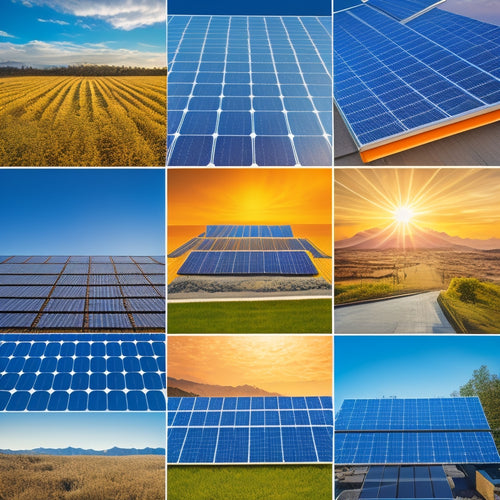
What's the Cost of California Residential Panels?
Share
You can expect to pay between $15,000 and $25,000 for residential solar panels in California. Costs depend on factors like panel efficiency and material quality. Labor expenses, which account for 10-20% of the total, range from $1,500 to $5,000. Federal and state incentives, including a 26% federal tax credit, can greatly reduce your out-of-pocket expenses. Financing options such as solar loans and leases make the upfront costs more manageable. Additionally, solar panels can save you around $1,400 annually and shield you from rising electricity prices. Discover more factors influencing your overall cost and long-term savings.
Key Takeaways
- Residential solar panels in California cost between $15,000 and $25,000 on average.
- Labor expenses for installation contribute $1,500 to $5,000 to the total cost.
- High-efficiency panels, while more expensive, offer better long-term energy production.
- Federal and state incentives can significantly reduce installation costs.
- Financing options like leases and loans provide flexible ways to manage upfront expenses.
Average Installation Costs
https://www.youtube.com/watch?v=DSpNHtFWcn0
The average installation costs for residential solar panels in California typically range between $15,000 and $25,000. The installation process starts with a site assessment, where technicians evaluate your roof's suitability for solar panels. This step guarantees ideal positioning for maximum sunlight exposure. Precision is vital here; incorrect placement can reduce efficiency and increase costs over time.
Labor costs form a significant portion of the total expense. In California, skilled labor is essential due to the intricate nature of installing solar panels. You need professionals who understand local regulations and safety standards. Labor typically accounts for 10-20% of the total installation cost. This means you're looking at $1,500 to $5,000 purely for the workforce. These figures might seem steep, but experienced installers ensure your system operates efficiently and safely.
Factors Affecting Prices
Several key factors greatly influence the prices of residential solar panel installations in California. First, panel efficiency plays a significant role. More efficient panels convert sunlight into electricity more effectively, reducing the number of panels you need. While high-efficiency panels can be more expensive upfront, their long-term energy production often justifies the cost.
Material quality also affects pricing. Panels made from premium materials like monocrystalline silicon generally cost more than those made from polycrystalline silicon, but they offer better performance and longevity. Investing in higher quality materials could mean fewer replacements and repairs over time, which saves you money in the long run.
The installation process itself is another important factor. Labor costs in California are relatively high, and the complexity of your roof can add to the expense. Simple, flat roofs are cheaper to work on compared to multi-faceted or steep ones.
Lastly, the size of the solar system impacts the total cost. Larger systems naturally require more panels and materials, increasing the overall price. However, larger installations often benefit from economies of scale, reducing the per-watt cost.
Understanding these factors empowers you to make informed decisions, maximizing both your financial and environmental returns.
Available Incentives
Understanding available incentives can greatly reduce the overall cost of residential solar panel installations in California. By leveraging government rebates and tax credits, you can substantially bring down your initial investment and long-term expenses.
The federal government offers the Solar Investment Tax Credit (ITC), allowing you to deduct 26% of the cost of installing a solar energy system from your federal taxes. This percentage is set to decrease in the coming years, so acting quickly can maximize your savings.
California also provides various state-specific incentives. The California Solar Initiative (CSI) previously offered direct rebates, but most programs are now fully subscribed. However, local utilities like PG&E, SCE, and SDG&E still offer rebates through their own programs. These rebates can vary based on your location and the size of your installation, so it's important to consult with your local utility provider.
Additionally, the Self-Generation Incentive Program (SGIP) provides rebates for energy storage systems, complementing your solar panel installation. This can further enhance your energy independence and financial savings.
Financing Options
After capitalizing on available incentives, exploring various financing options can further reduce your out-of-pocket costs for residential solar panel installations in California. Two primary avenues to explore are leasing options and solar loans, each offering unique benefits tailored to different financial situations.
Leasing options allow you to install solar panels without the hefty upfront cost. Instead, you pay a fixed monthly fee to a solar company that owns and maintains the system. This option provides immediate access to solar energy benefits, but it's important to read the fine print. Some leases might include annual escalators, increasing your payments over time.
On the other hand, solar loans offer a path to ownership with flexible terms. Securing a solar loan means you can finance the entire installation cost while paying it off over several years. Data shows that interest rates for solar loans typically range from 3% to 8%, depending on your credit score and the loan term.
Unlike leasing, owning your system through a loan allows you to benefit from federal tax credits and other incentives directly.
Long-Term Savings
Investing in residential solar panels in California can yield substantial long-term savings by greatly reducing or even eliminating your monthly electricity bills. On average, Californian households consume around 7,000 kWh annually. By installing a solar panel system that meets this demand, you can save approximately $1,400 per year, assuming the average electricity rate of $0.20 per kWh. Over a 25-year lifespan of a solar panel system, that's a potential savings of $35,000.
Moreover, achieving energy independence means you're insulated from the volatility of energy markets. Electricity prices in California have been rising at an average rate of 3.5% per year. By harnessing solar energy, you lock in your energy costs at a fixed rate, shielding yourself from future price hikes.
Beyond financial gains, consider the environmental benefits. A typical residential solar panel system can offset about 3 to 4 tons of carbon dioxide annually. Over its lifetime, this translates to a reduction of 75 to 100 tons of CO2, contributing to a cleaner, greener planet.
Frequently Asked Questions
How Long Do Residential Solar Panels Typically Last?
Residential solar panels typically last 25-30 years. Lifespan factors include weather conditions and maintenance quality. Efficiency degradation is about 0.5% per year, so after 25 years, they'll operate at roughly 88% of original efficiency.
What Maintenance Is Required for Residential Solar Panels?
You'll need a regular cleaning schedule to maximize efficiency and prevent damage. Data suggests biannual cleanings suffice, though areas with heavy debris might require more. Inspect for damage periodically to guarantee longevity and peak performance.
Are There Specific Permits Needed to Install Solar Panels in California?
In California, you're required to navigate the permit fees and application process for solar panel installation. While this may seem challenging, it guarantees safety and compliance, ultimately granting you the freedom from high utility bills.
How Do Solar Panels Perform in Different Weather Conditions?
You'll find that solar panels' performance varies with weather impact. During winter, efficiency drops due to shorter days and cloud cover. However, summer boosts seasonal efficiency with longer, sunnier days, maximizing energy production and independence.
Can Solar Panels Increase the Resale Value of My Home?
Imagine your home as a treasure chest—solar panels can be the key. Data shows they often boost property value and positively impact home appraisals. Buyers appreciate energy savings, making your home more attractive and valuable.
Related Posts
-

Solar Power for Reducing Carbon Footprint
Solar power is an effective strategy for reducing your carbon footprint. By adopting solar energy, you can cut greenh...
-

How to Reduce Home Energy Bills
To reduce your home energy bills, start by investing in energy-efficient appliances and upgrading your insulation. Lo...
-

Comparative Analysis of Top Solar Brands
To conduct a comparative analysis of top solar brands, focus on key metrics like durability, energy efficiency, and s...


